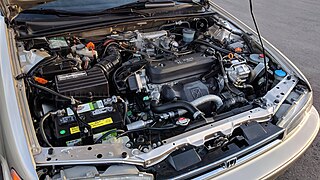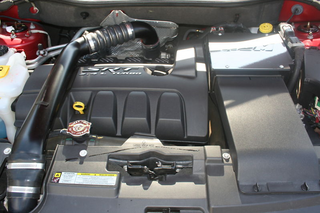Related Research Articles

The Mazda Tribute is a compact SUV made by Japanese automaker Mazda from 2000 to 2011. It was jointly developed with Ford Motor Company and based on the front-wheel drive Mazda 626 platform, which was in turn the basis for the similar Ford Escape on the CD2 platform. The Tribute was priced below the Ford Escape and Mercury Mariner in Ford's CD2 SUV lineup.

The Ford Pinto engine was the unofficial name for a four-cylinder internal combustion engine built by Ford Europe. In Ford sales literature, it was referred to as the EAO or OHC engine and because it was designed to the metric system, it was sometimes called the "metric engine". The internal Ford codename for the unit was the T88-series engine. European Ford service literature refers to it as the Taunus In-Line engine. In North America it was known as the Lima In-Line (LL), or simply the Lima engine due to its being manufactured at Lima Engine in Lima, Ohio.

The General Motors LS-based small-block engines are a family of V8 and V6 engines designed and manufactured by American automotive company General Motors. First introduced in 1997, the family is a continuation of the earlier first- and second-generation Chevrolet small-block engine, of which over 100 million have been produced altogether, and is also considered to be one of the most popular V8 engines ever. Spanning three generations, a new, sixth generation is expected to enter production soon. Various small-block V8s were and still are available as crate engines.

Ethan Allen was a major American arms maker from Massachusetts. He is unrelated to the revolutionary Ethan Allen. His first firearm, the "Pocket rifle" was developed in 1836, and his first patent was granted in 1837.

The Willys F4-134 Hurricane was an inline-4 F-head piston engine that powered the M38A1 military Jeep in 1952, followed by the famous Jeep CJ in the CJ-3B, CJ-5, and CJ-6 models. It was also used in the Willys 473 and 475 pickups, wagons, and sedan deliveries. It replaced the Willys Go Devil engine that was used in the MB Jeep and other early Jeep-based models like the Jeepster. This engine was also built by Mitsubishi for their license-built Jeep, as well as other applications.

The Nissan Pintara is a compact automobile that was manufactured by Nissan Motor Australia from 1986 until 1992.

The Nissan Skyline is a brand of automobile originally produced by the Prince Motor Company starting in 1957, and then by Nissan after the two companies merged in 1967. After the merger, the Skyline and its larger counterpart, the Nissan Gloria, were sold in Japan at dealership sales channels called Nissan Prince Shop.

In automotive engineering a multi-valve or multivalve engine is one where each cylinder has more than two valves. A multi-valve engine has better breathing and may be able to operate at higher revolutions per minute (RPM) than a two-valve engine, delivering more power.

The Honda A series inline-four cylinder engine is used in 1980s Honda Accord and Prelude models. It was introduced in 1982, with the second-generation Honda Prelude, and available in three displacement sizes: 1.6-, 1.8- and 2.0-liters. It features cast iron block and aluminum SOHC head design with three valves per cylinder for a total of 12 valves. It was available in carbureted and fuel-injected configurations

The Nissan Z engine is a series of automobile and light truck four-cylinder engines that was engineered by Nissan Machinery, manufactured by the Nissan Motor Company from 1979 through August 1989. All Z engines had 4 cylinders, a total of 8 valves and a single overhead camshaft (SOHC). Displacements ranged from 1.6 L to 2.4 L.The Z series' engine blocks were nearly identical to those of the earlier L Series with the exception of the Z24. While the Z16 and Z18 engines had a deck height similar to the earlier L13/L14/L16/L18 variants, the Z24 had a taller deck height to accommodate a longer stroke. The most notable difference between the Z-series engine and its predecessor was the introduction of a new crossflow cylinder head which reduced emissions by moving the intake ports to the right side of the engine opposite the exhaust ports. This change allows the exhaust port velocity to more effectively scavenge the cylinder and reduce reversion pulses to enhance induction. This change also limits maximum valve lift/lobe lift profiles rendering the cylinder head and valve train configuration undesirable for high-performance uses. The Z series evolved into the NA and KA engines which, along with the smaller CA series, replaced the Z series.

The Chrysler Hemi engines, known by the trademark Hemi or HEMI, are a series of American V8 gasoline engines built by Chrysler with overhead valve hemispherical combustion chambers. Three different types of Hemi engines have been built by Chrysler for automobiles: the first from 1951 to 1958, the second from 1964 to 1971, and the third from 2003 to 2024. Although Chrysler is most identified with the use of "Hemi" as a marketing term, many other auto manufacturers have incorporated similar designs. The engine block and cylinder heads were cast and manufactured at Indianapolis Foundry.

The Honda F-Series engine was considered Honda's "big block" SOHC inline four, though lower production DOHC versions of the F-series were built. It features a solid iron or aluminum open deck cast iron sleeved block and aluminum/magnesium cylinder head.

The Fleet Finch is a two-seat, tandem training biplane produced by Fleet Aircraft of Fort Erie, Ontario. There were a number of variants mainly based on engine variations. Over several years beginning in 1939, a total of 447 Finches were built, nearly all (431) of them for use as elementary trainers in the British Commonwealth Air Training Plan (BCATP) during the Second World War.

The Smith & Wesson (S&W) Model 12 is a .38 Special revolver on Smith & Wesson's medium-sized K-frame. It is an aluminium alloy-frame version of the Model 10. It was made from 1953 to 1986 in both two-inch (50.8 mm), 17 ounces (482g) and four-inch (101.6 mm), 19 ounces (539g) configurations. Early models used an aluminum cylinder as well as frame.

In the 1930s, Fleet Aircraft manufactured a series of single-engined, two-seat training aircraft, based on US designs. The Fleet Model 7B and Model 7C, known respectively as Fawn I and Fawn II were purchased by the RCAF as primary trainers. After years of reliable service, many were available for use in the British Commonwealth Air Training Plan during the Second World War while others remained as station "hacks."

The Fairchild 22 Model C7 was an American two-seat touring or training monoplane designed and built by the Kreider-Reisner division of the Fairchild Aircraft Corporation at Hagerstown, Maryland.

The London and North Eastern Railway (LNER) Class A2/3 was a class of 4-6-2 steam locomotives. They were newly constructed locomotives, fulfilling the requirement identified by Edward Thompson for a standard express passenger locomotive of the 4-6-2 arrangement with 6 ft 2 in (1.880 m) driving wheels. Fifteen engines were constructed according to this original design, but following the retirement of Thompson as CME, the remaining fifteen locomotives that were planned were immediately redesigned and ultimately emerged as Peppercorn Class A2.

The World Gasoline Engine is a family of straight-4 piston engines, based on the Global Engine Alliance design.

The Honda C92 Benly is a 125 cc (7.6 cu in) parallel-twin motorcycle made by Honda from 1959 through 1965. Running concurrently were the CB92 Sports and the slightly larger C95 150 cc (9.2 cu in), called the CA92 and CA95 in the US. These twins took their styling and design cues from the larger-displacement Honda C71, C76, C72, C77 Dream series.
References
- G. Marshall Naul, "Allen (i)”, in G.N. Georgano, ed., The Complete Encyclopedia of Motorcars 1885-1968 (New York: E.P. Dutton and Co., 1974), pp. 36.